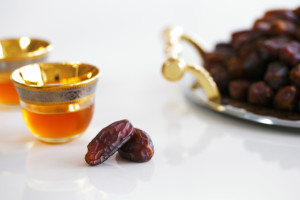Close to 25 percent of the world’s population is Muslim, and Ramadan is Islam’s most holiest times. It always falls on the ninth month of the Islamic calendar, which is lunar based. In 2015, Ramadan begins at sundown on June 17 and lasts until July 16. The date of the holiday fluctuates each year and typically starts eleven days sooner than the previous year. During the decade 2010–2020, Ramadan begins as early as April 24 and as late as August 11. After approximately 33 years, the date will have migrated across the 12 month calendar. Every month on the Islamic calendar starts when the new crescent moon appears.
Five Pillars of Islam
During Ramadan, Muslims fast from sunrise to sunset. The practice is mandatory for adults, but many children also participate. Fasting during Ramadan is one of the five most important tenets of Islam, also referred to as the “five pillars of Islam.” They are the basis for Muslim life and described as follows:
Shahadah: acknowledgement of only one God and God’s messenger Muhammed
Salat: praying five times per day
Zakat: contributing 2.5 percent of your income to the less fortunate
Sawm: fasting during Ramadan
Hajj: if possible, embarking on a pilgrimage to Mecca at least once in your life.
A Time of Restraint
Fasting is intended to give Muslims a greater understanding of what it is like to be hungry, and instill more empathy for the less fortunate. Being hungry during the day can lead to increased appreciation of the bounties of Allah, the Muslim God, which may be taken for granted when one’s belly is full. In addition to fasting during daylight hours, Muslims are expected to practice restraint and self-sacrifice during the month by abstaining from all vices, conscious and unconscious. If they can renounce the many evils of the world during Ramadan, it may give them more strength to do so during the rest of the year. Ramadan is also a time of generosity and charity, and followers of Islam are encouraged to help the poor by donating money to charities.
Popular Foods During Ramadan
After the sun has set, many families and friends gather for special meals during Ramadan called Iftar dinners. Some of the foods served include:
Dates
The prophet Muhammed is believed to have encouraged eating dates after a day of fasting.
Amar al-Deen
A drink made of chopped up apricots that have been submerged in water for many hours. The resulting paste is mixed with water so it is smooth enough to drink.
Mahshi
Vegetables such as zucchinis, peppers and eggplants stuffed with flavored rice
Soup
Soup is frequently served during Ramadan and lentils, vegetables and chicken are common ingredients.
Beans and salads
Bean dishes such as hummus, made from chickpeas, and green salads like tabbouleh, made from parsley, tomatoes, onions, cous cous, olive oil and lemon juice, are often consumed during Ramadan.
Qatayef
Qatayef is a dessert similar to crepes stuffed with nuts or cheese and served with honey. It is typically eaten at the end of Ramadan.
Last Days of Ramadan
The final 10 days of the month are considered the most sacred. The 27th night of Ramadan is particularly blessed and referred to as the “Night of Destiny.” Many Muslims stay up during this very spiritual time, pray, and recite passages from the Quran. Eid-ul-Fitr marks the end of Ramadan’s month-long fasting period. It is a day of celebration and many Muslims gather together to say prayers of thanks. It is also customary to wear new outfits, exchange gifts and eat traditional foods.
The month of Ramadan is one of the most sacred periods of the year for Muslims. Fasting is an integral part of the holiday and there are numerous other traditions as well.


